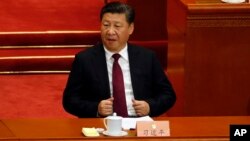With major political changes on the Communist Party’s agenda in 2017, China is expected to avoid taking decisive reform measures that could result in large scale job losses and put pressure on the leadership.
One of the measures suggested by the Organization for Economic Development and Cooperation (OECD), which released its “Economic Survey of China” last week, is the complete closure of money-losing, state-run companies.
The report from the OECD also called for changes in the bankruptcy law to fill loopholes that allow laggard enterprises to survive at public expenses. Such companies have piled up an amount of corporate debt equal to 170 percent of China’s gross domestic product.
OECD’s warning
“Seventy percent of corporate debt is state-owned enterprises (SOE) debt. These so-called ‘zombie’ firms should be allowed to exit and get out of the market, or reform or consolidate,” Alvaro S. Pereira, OECD Director of Country Studies, told VOA.
“...If you let too many zombie firms in debt terms to stay around, I think this is bad for the economy because they are diverting resources that can be used in a much better way elsewhere,” he said.
Politics of reforms
Such advice seems unlikely to be addressed ahead of the Communist Party Congress to take place later this year. The crucial conclave is expected to elect a new set of leaders in the Politburo Standing Committee, the country’s most powerful body, and re-elect its general secretary, President Xi Jinping, for a second five-year term.
Restructuring or closing down major enterprises could result in massive job losses and resentment among the well-networked officials who run them.
Max J. Zenglein, a research associate with the Mercator Institute of Chinese Studies (Merics) in Berlin, said communist leaders are lot more interested in ensuring social and political stability during this period of economic slowdown than reforms.
“Persistent downward pressure on the economy make any substantial reform effort prior to the Party Congress unlikely,” he said. “The government will want to avoid any form of social instability.”
Baying at the moon
Some experts say there is a conflict between the need for reforms and the political goals of Chinese leaders.
“Xi Jinping is far more comfortable with government and party control than with markets,” said Scott Kennedy, director of the project on Chinese business and political economy at the Washington-based Center for Strategic and International Studies.
“The Chinese leadership has not moved forward on SOE reform because the leadership does not believe in this approach,” he said. “Instead, they want to keep SOEs afloat because they are keys to the Communist Party’s power and international influence.”
Reforms would mean opening up economy sectors that are reserved for state owned firms, and punishing their managers for mistakes that led to heavy debt burden and losses. It would also mean opening up several closed sectors for private and foreign businesses, which do not adhere to the Communist Party’s control mechanism.
Messy affair
Warren B. Bailey, professor of finance at Cornell’s Samuel Curtis Johnson Graduate School of Management, emphasized the distance between the goals of reforms and the political objectives of leaders.
“The more fundamental problem is that SOE bankruptcy is messy, embarrassing, costs jobs, cuts off benefits for those who feed off these firms,” he said.
“The biggest challenge in dealing with over-capacities are domestic politics and vested interests within state-owned companies,” said Zenglein of Merics. The government is only hesitant to resolve as its main concern is maintaining economic stability, he said.
But some reforms cannot be avoided. Companies in coal and steel sectors have piled up huge inventories of unsold stock, and have begun to bleed banks that lend them money to survive. The government has allocated $23 billion to pay compensation to workers who will be laid off after the closure of mines and mills over the next two years. Last week, China allocated an additional $4.36 billion to a SOE Structure Adjustment Fund, which will facilitate mergers and acquisitions, and other forms of restructuring state-owned enterprises.
But some experts see these measures as no more than scratching the surface of a gigantic problem.
“There is little evidence of any substantial improvements (in SOE governance) in spite of changes in laws, regulations, stock market listings, or other institutional developments that claim to improve quality. I am pessimistic,” Bailey said.
There is another reason why the government is walking cautiously towards reform goals. Closing down or restructuring zombie firms would prove to be a severe blow to banks, which have lent billions of dollars to them.
“I think China’s banks are holding a lot of debt, on and off their balance sheets, and rigorously enforcing bankruptcy might put some of these financial institutions in harm’s way,” Kennedy said.









